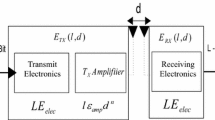Abstract
This study proposes a number of scheduling schedules for data transmission in cluster-based wireless sensor networks in order to make energy-saving improvements to sensor nodes. The four states are defined in each network cycle so that sensor nodes can report the events happened in the network. A clustering mechanism creates appropriate network topologies to distribute energy consumption among energy-sufficient sensor nodes. Nodes can adjust the duty cycles for data collection during network lifetime. The scheduling schemes reduce the probabilities of communication collision and duplicate transmission using a broadcast delay. We examine the storage, communication, and computation requirements for the proposed scheduling scheme. All the overheads are sensible, given the current state of device technology of sensor nodes. The experimental results show that nodes work in high efficiency cluster-based networks by the proposed schemes.








Similar content being viewed by others
References
Li, J., & Jiang, S. (2010). An energy efficient clustering algorithm in large-scale mobile sensor networks. The Second International Conference on Networks Security, Wireless Communications and Trusted Computing, April, 24–25.
Banerjee, I., Das, S., Rahaman, H., & Sikdar, B. K. (2006). An energy efficient monitoring of ad-hoc sensor network with cellular automata. IEEE International Conference on Systems, Man, and Cybernetics, October, 8–11.
Garcia, M., Sendra, S., Lloret, J., & Canovas, A. (2011). Saving energy and improving communications using cooperative group-based wireless sensor networks. Telecommunication Systems. doi:10.1007/s11235-011-9568-3.
Heinzelman, W. B., Chandrakasan, A., & Balakrishnan, H. (2002). An application specific protocol architecture for wireless microsensor network. IEEE Transactions on Wireless Communications, 1(4), 660–670.
Hsieh, M. Y. (2011). Data aggregation model using energy-efficient delay scheduling in multi-hop hierarchical wireless sensor networks. IET Communications, 5(18), 2595–2759.
Huang, Y. M., Hsieh, M. Y., Chao, H. C., Hung, S. H., & Park, J. H. (2009). Pervasive, secure access to a hierarchical-based healthcare monitoring architecture in wireless heterogeneous sensor networks. IEEE Journal on Selected Areas in Communications, 27(4), 400–411.
Bulusu, N., Heidemann, J., & Estrin, D. (2000). GPS-less low cost outdoor localization for very small devices. IEEE Personal Communications, 7(5), 28–34.
Inoue, Y., Endo, K., & Takahashi, Y. (2010). A distance-aware forwarding protocol for beaconless communication in mobile ad hoc networks and its performance. Proceedings of the 5th Annual International Wireless Internet Conference, Singapore, March 1–3.
Ye, W., Heidemann, J., & Estrin, D. (2002). An energy-efficient MAC protocol for wireless sensor networks. Proceedings IEEE INFOCOM 2002. June (pp. 1567–1576).
Lu, G., Krishnamachari, B., & Raghavendra, C. (2004). An adaptive energy-efficient and low-latency MAC for data gathering in sensor networks. In: Workshop on Energy-Efficient Wireless Communications and Networks, April.
Hurni, P., Braun, T., & Anwander, M. (2010). Evaluation of WiseMAC and extensions on wireless sensor nodes. Telecommunication Systems. doi:10.1007/s11235-009-9196-3.
Yoon, S., & Kim, C. (2007). Residual energy prediction scheme for wireless sensor devices. The 9th International Conference on Advanced Communication Technology, February (pp. 979–981).
Jin, K. S., McEachen, J. C., & Singh, G. (2006). RF characteristics of Mica-Z wireless sensor network motes. The 49th IEEE International Midwest Symposium on Circuits and Systems (pp. 100–104).
TinyOS. http://www.tinyos.net/.
Hsieh, M. Y., Deng, D. J., Lin, W. D., Yeh, C. H., & Li, K. C. (2012). Self-decision activity in hierarchical wireless sensor networks. Information: An International Interdisciplinary Journal, 15(6), 597–606.
Nasser, N., Al-Yatama, A., & Saleh, K. (2012). Zone-based routing protocol with mobility consideration for wireless sensor networks. Telecommunication Systems. doi:10.1007/s11235-011-9562-9.
Acknowledgments
The work is supported by the Ministry of Science and Technology, Taiwan, under Grant NSC 102-2221-E-126-003-.
Author information
Authors and Affiliations
Corresponding author
Rights and permissions
About this article
Cite this article
Hsieh, MY., Ding, JW. Dynamic scheduling with energy-efficient transmissions in hierarchical wireless sensor networks. Telecommun Syst 60, 95–105 (2015). https://doi.org/10.1007/s11235-014-9924-1
Published:
Issue Date:
DOI: https://doi.org/10.1007/s11235-014-9924-1




